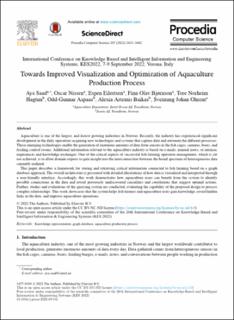| dc.contributor.author | Saad, Aya | |
| dc.contributor.author | Nissen, Oscar | |
| dc.contributor.author | Eilertsen, Espen | |
| dc.contributor.author | Bjørnson, Finn Olav | |
| dc.contributor.author | Norheim Hagtun, Tore | |
| dc.contributor.author | Aspaas, Odd Gunnar | |
| dc.contributor.author | Artemis Baikas, Alexia | |
| dc.contributor.author | Ohrem, Sveinung Johan | |
| dc.date.accessioned | 2022-10-31T14:44:00Z | |
| dc.date.available | 2022-10-31T14:44:00Z | |
| dc.date.created | 2022-09-12T14:17:23Z | |
| dc.date.issued | 2022 | |
| dc.identifier.citation | Procedia Computer Science. 2022, 207 3439-3448. | en_US |
| dc.identifier.issn | 1877-0509 | |
| dc.identifier.uri | https://hdl.handle.net/11250/3029195 | |
| dc.description.abstract | Aquaculture is one of the largest, and fastest growing industries in Norway. Recently, the industry has experienced significant development in the daily operations acquiring new technologies and systems that capture data and automate the different processes. These emerging technologies enable the generation of enormous amounts of data from sensors in the fish cages, cameras, boats, and feeding control rooms. Additional information relevant to the aquaculture industry is based on e-mails, manual notes, or intrinsic experiences and knowledge exchanges. One of the critical aspects of successful fish farming operation management, which is yet not achieved, is to allow domain experts to gain insight into the interconnection between the broad spectrum of heterogeneous data currently realized. This paper describes a graph-based database approach to storing and retrieving critical information connected to fish farming operations. The overall architecture is presented with detailed illustrations of how data is visualized and interpreted through a user-friendly interface. Accordingly, this work demonstrates how aquaculture users can benefit from the system to identify possible connections in the data and reveal previously undiscovered causalities and correlations that suggest optimal actions. Further, studies and evaluations of the querying system are conducted, evaluating the capability of the proposed design to process complex relationships. This work showcases that the system helps fish farmers and aquaculture users gain knowledge, reveal hidden links in the data, and improve aquaculture operations. | en_US |
| dc.language.iso | eng | en_US |
| dc.publisher | Elsevier | en_US |
| dc.rights | Attribution-NonCommercial-NoDerivatives 4.0 Internasjonal | * |
| dc.rights.uri | http://creativecommons.org/licenses/by-nc-nd/4.0/deed.no | * |
| dc.subject | aquaculture production process | en_US |
| dc.subject | graph database | en_US |
| dc.subject | Knowledge representation | en_US |
| dc.title | Towards Improved Visualization and Optimization of Aquaculture Production Process | en_US |
| dc.title.alternative | Towards Improved Visualization and Optimization of Aquaculture Production Process | en_US |
| dc.type | Peer reviewed | en_US |
| dc.type | Journal article | en_US |
| dc.description.version | publishedVersion | en_US |
| dc.rights.holder | © 2022 The Authors. Published by Elsevier B.V | en_US |
| dc.source.pagenumber | 3439-3448 | en_US |
| dc.source.volume | 207 | en_US |
| dc.source.journal | Procedia Computer Science | en_US |
| dc.identifier.doi | 10.1016/j.procs.2022.09.531 | |
| dc.identifier.cristin | 2050868 | |
| dc.relation.project | Norges forskningsråd: 321422 | en_US |
| cristin.ispublished | true | |
| cristin.fulltext | original | |
| cristin.qualitycode | 1 | |

